Extract from The Guardian

Main image: Donald Trump and Scott Morrison at a ceremonial welcome on the south lawn of the White House. Photograph: Mick Tsikas/AAP
Australian PM Scott Morrison received a full-blown welcome from the
US president. Katharine Murphy was on hand for an inside account
- Support our independent journalism with a one-off or recurring contribution
Scott Morrison has made his first visit to the United States as
prime minister. It was a trip that included a close encounter with the
unpredictability of the Trump White House, a foreign policy pivot, and a
backlash about a lack of climate policy action. Guardian Australia’s
political editor, Katharine Murphy, travelled, with the prime minister. Here is what she witnessed:
We are greeted by a blond woman in a broad-brimmed hat. June, a self-described southern belle, is receiving visitors in the briefing room, although it’s not clear why. She identifies herself as a fellow scribe working for Christian radio and television in Nashville. When she’s not reporting on the Trump White House, she’s rallying Christians for the president. This seems something of a line cross for a reporter with White House press accreditation – but we’ve been on the premises for about 10 minutes and it’s clear that we’re not in Kansas any more.
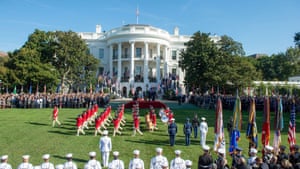
Washington
We’ve been positioned at the White House since 5am, watching the sun creep over the American capital. Security is as laborious as you’d expect. Dogs sniff bags, then the secret service guys have a good look, passports are collected, checked and returned, White House passes and pins are distributed, and then at last we clear the metal detectors. Eventually we make it to the press briefing room, the small blue one, famous through several presidential administrations but now abandoned by Donald Trump. The modest proportions don’t fit his presidency. Now it’s just a transit zone.We are greeted by a blond woman in a broad-brimmed hat. June, a self-described southern belle, is receiving visitors in the briefing room, although it’s not clear why. She identifies herself as a fellow scribe working for Christian radio and television in Nashville. When she’s not reporting on the Trump White House, she’s rallying Christians for the president. This seems something of a line cross for a reporter with White House press accreditation – but we’ve been on the premises for about 10 minutes and it’s clear that we’re not in Kansas any more.

The Donald’s grass is lush and slightly dewy, making me regret my choice of footwear. The daylight is now dazzling but the bucolic scene is disturbed by Austin rebuking Steve in the media pen. The confrontation happens just before the splendidly peppy pipe band strides across the lawn for the ceremonial welcome.
I’ve never met Austin before this moment but he looks about 30, buttoned down and watchful as a raptor – a White House wrangler who looks as though he hasn’t sat down, eaten anything apart from a protein bar, or slept more than four hours straight a night since early infancy. Steve has transgressed and Austin convenes a short, sharp show trial in front of me. I’ve nabbed a prime position on the fence in the media pen right in front of the entrance, and I don’t intend to move unless the secret service guy standing beside me gets feisty.
“You left the media area to make a call,” Austin says, voice appropriately low so as not to disdain the Wonderful Occasion swelling around us. Steve is older than his accuser and possesses the rumpled look of a longtime print or news wire reporter. I’ve never seen Steve before either, but he’s clearly part of the White House press pool and looks like a man disinclined to small talk. My guess, from my quick scan of the body language, the suppressed inner sigh, is that Steve has seen a number of Austins in his reporting lifetime, perhaps a small production line of them, and is not much gripped by this power play.
Steve says nothing. Austin persists. In a minute we are going to go full Veep. “The secret service told me you left the media area to make a call – is this correct?” Steve, at the end of his tolerance for J’Accuse now, delivers his mic drop. “Yah,” he says. “One of the secret service guys held back the rope so I could get out to make the call. I needed to take the call.” I suspect Austin doesn’t really know where to take this from here. The aide returns to the front of the fence, shoulders back, eyes front. It’s showtime.
Trump strides out of the White House with Melania. From my vantage point they look like a pair of Easter Island statues. This is my first encounter with the current leader of the free world and my curiosity is intense. How will Trump look uncut?

Over the next little while, Trump will lavish praise on Melania for her crack presidential spouse skills. The first lady, Trump reports over and over during the course of Friday, “worked so hard” on the table settings for the state dinner, pondering every detail. The flowers, the centrepieces, so wonderful, so beautiful. The best table decorations anyone has ever seen.
It’s hard for me to imagine the reality of the first lady’s life, what it must be like to agonise over centrepieces for state dinners amid the sound and fury of her husband’s bitterly contested presidency. Given her reserved public presence, it feels like an impertinence to wonder.
There’s no time for whimsy in any case, because the Morrisons are now on the premises, ready for their induction into the Trumpiverse. In comparison with the Trumps, Scott and Jenny Morrison, from the Sutherland shire, Australia – more latterly of Kirribilli House – look like a well-to-do couple from the suburbs. They are earthed in this big moment, respectful of the tradition they are now associated with, the tradition of Washington’s special friends being drawn to the nation’s bosom.
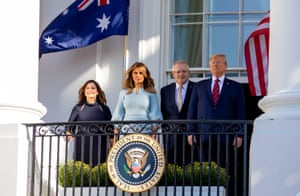
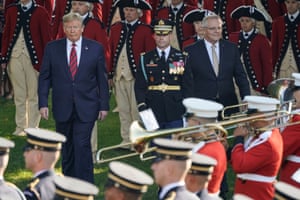
She also gives us tremendously helpful advice: Trump will be on for a rave when we get in there. We are surprised by this. Our assumption was we’d be in and out in a matter of minutes. Our river guide shakes her head. Trump, she says, is in an expansive frame of mind. Best we prepare some questions. She also predicts that Trump will struggle to understand our accents. If he doesn’t understand, the president will say: “Say it.” This means ask the question again, she says.
I assume this is some sort of weird in-joke until I hear Trump do just that. “Say it,” Trump says, narrowing his eyes and curling his lip. It’s utterly peculiar, but it’s an earworm. Once you hear it, it’s hard to get the locution out of your brain. Say it.
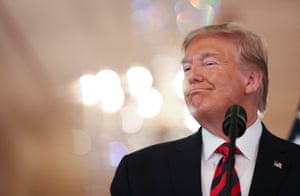
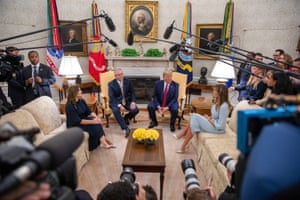
Once we realise this is going to be nuts – a small blazing blitzkrieg at the seat of American power with no rules of engagement – Australian reporters also start hurling questions across a range of topics. Trump looks delighted by the disorder. It’s where he thrives. Morrison shifts in his seat.
The president lays into the media. We are hopeless, finished, friendless. But Mr President, what about the call? Did you speak to Ukraine’s new president? It was a beautiful call. Next question. Say it.
The Morrisons sit tight as the stiff westerly blows. The prime minister isn’t visibly alarmed but he’s hyper alert. Jenny Morrison composes her face into a placid mask – until Trump suddenly raises the spectre of nuclear weapons and Iran. I catch her eye at that moment and she startles, ever so slightly. Her eyes, to me, say “help me”. I catch Morrison’s eye a couple of times and the corners of his mouth crinkle.

Eventually Trump stops feeling all the feelings and we are herded out. I ask one of my fellow travelling reporters whether the president just raised the prospect of nuclear attack, because I fear the sleep deprivation might be messing with my cognition. He’s as knocked around as I am. Yes, he thinks so, but he needs to listen to the recording. TV reporters are wondering out loud how on earth they are going to distil what just happened into a package. How do you do this in a minute and a half?
At the height of my disorientation, I spot Paul Murray from Sky’s Fox News lite after-dark crew at the back of the room. As we are guided out, Morrison beckons Murray forward and introduces him to the president. This introduction yields an exclusive interview with Trump which includes the simpering question: “What do you want to say to your many Australian supporters who wish you nothing but the best in November 2020?” I suppose it could have been what was his favourite colour.
Paul Murray gets his exclusive with @realDonaldTrump but talk about not asking the hard questions.
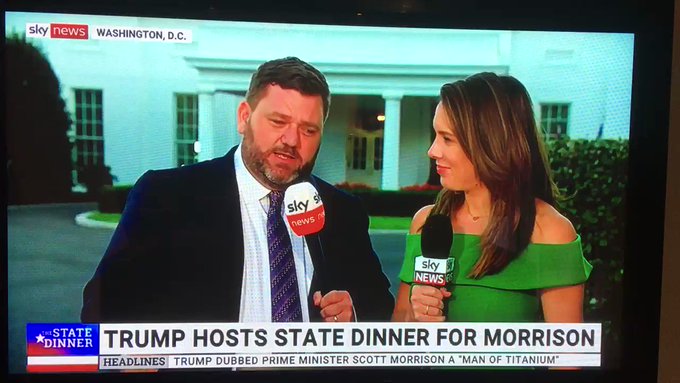
The madness persists. The day ends with wranglers trying to
facilitate some access to the state dinner, which is al fresco, in the
Rose Garden. As we are herded through the South Lawn accompanied by the
lilt of violins serenading guests and the murmur of clinking glassware
and small talk, a secret service guy in night goggles, with foliage in
his helmet, suddenly materialises from the bushes and sprints across in
front of us.
Paul Murray gets his exclusive with @realDonaldTrump but talk about not asking the hard questions.


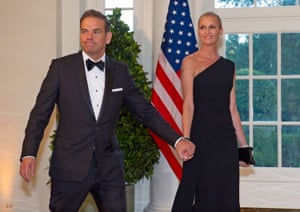
In Hockey’s garden I strike up a conversation with an expatriate pub owner who is now the mayor of Annapolis and is campaigning to tighten gun control. Gavin Buckley, formerly from Western Australia, is an avuncular Democrat at a Republican knees-up, a fish out of water who can’t quite believe his luck. Buckley tells me he hugged Hockey for the great honour bestowed upon him.
The whole scene is F Scott Fitzgerald meets the pre-woke capitalism of the 1980s, and the humidity is sending us all bonkers. Servers hand out party pies and sausages with disturbing names like cheese and Vegemite, and bald men in linen sports jackets compete for shade. One of our travelling media pack then proceeds to conduct a mock interview of a new magnolia tree which has just been planted to celebrate the Morrison state visit. With the Magnolia, this is Brett Mason, SBS News. It’s a joke, hijinks to help us stay alert when we are hitting that hour of the day when jetlag threatens to take your legs out. But we’ve crossed the sense barrier and we haven’t even hit the Trump rally. What could possibly go wrong?
Ohio
It’s a voyage with billionaires, this American excursion with Morrison. I confess that this is new territory for me. The cashed-up and politically connected drifted past us during the pomp and circumstance in Washington, and now we are closing in on Anthony Pratt as we speed to Wapakoneta, first airborne and then jammed in Morrison’s motorcade with police cars racing past, sirens blaring, to stop traffic on the freeway.
One of Morrison’s press secretaries, Nick Creevey, has joined us for the sprint to Wapakoneta on the commandeered Dayton school bus. We’re all practising the pronunciation of Wapakoneta. Wah-pa, Christ, how do you spell this bloody place again? Katina Curtis, the meticulously prepared Australian Associated Press reporter, is patient with the spelling drills. Hey Katina. How do you spell …
There are few female journalists on this trip, and overseas voyages, in my experience, tend to take on an Aussie barbecue dimension. This is a generalisation but, as generalisations go, not an unfair one. Male correspondents largely herd together, socialise together, crack jokes together, reinforce one another’s insights, and women run on a parallel track. It’s a strange dynamic at times; stranger because the blokes who engage in the behaviour would be entirely unconscious that’s what’s happening. It’s just custom, or muscle memory. Hashtag road trip. Hashtag dudes.
Dayton to Wapakoneta is flat and rural. The billboards we pass are a combination of fast food temptations and Jesus Christ, saving the born and unborn. I’m both fascinated to learn what we are driving into and mildly apprehensive, given that Trump rallies can be hostile to the media covering them, and hackles in the base must be raised by the latest mainstream media pursuit over Trump and Ukraine. The president loves a persecution narrative with him at the centre of it – it fuels the righteous rage of his supporters. Everyone can be aggrieved together.
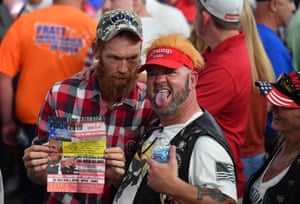
Nobody in the PM’s entourage expresses any apprehension at all about Ohio, not even a hint of it. But my instinct suggests they are also worried about the unknown. There are risks in the look of this thing. Should Morrison really be at a Trump rally (even though the Ohio event is more complicated than a 2020 campaign whistle stop with Morrison attached). Apart from the possibility of any bizarre, indefensible off-piste business, there is also the risk of Trump banging on and on and on. It is entirely possible scheduled remarks at the opening of a box factory could stretch into a Castroesque monologue that kills our logistics stone dead. Morrison’s crew had expected the Oval Office encounter to last for a few minutes and instead it stretched, putting them behind for the remainder of the day.
I filed a column describing our arrival into Wapakoneta and the rapturous welcome the locals gave Trump, but there were some other memorable moments behind the scenes. When Trump and his entourage finally blow in to town in a blaze of police sirens and secret service agents, we are reunited with the same White House press pool we met on Friday outside the Oval, grinding through another event. I clock Steve in the distance, kicking on.
Trump engages Pratt the minute he’s in the factory. The two billionaires exchange lavish compliments as they amble towards the gaggle of reporters. Presumably the box maker is explaining recycling to Trump as they go. Rubbish in, box out, cash in.
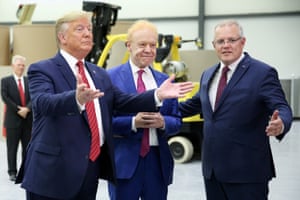
Pratt is entirely comfortable with the word. Pratt Industries, Ohio, is proudly euphemism-free. Trump picks up the story: “They start off with waste, garbage, and they end up building it into a – making it into really great cardboard and paper.”
“A hundred per cent of the plant”. As I mentioned earlier, I’ve never seen Steve before these couple of brief encounters, he is a complete stranger to me, and what follows is pure speculation, but I’m going to hazard a guess that he knows what recycling is. I reckon Steve does know about it.
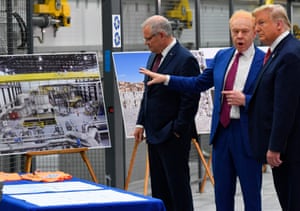
Trump continues to roll this newfangled Pratt magic around in his mind, and engage journalists enthusiastically along the fence line. “That’s really some equipment. The finest equipment in the world. And more and more people are going this way.
“Normally, you take down trees and you make the paper. In this case, Anthony does 90, 95% out of waste, out of garbage, and they make incredible final product through a very – through really a very – a really costly but efficient process.” He could be describing the interface between tycoons and politicians but let’s not be caustic or labour the metaphor. We need to continue with our story.
Emboldened by this level of engagement from the president, one of the Australian journalists calls out: “Do you want more businessmen like Mr Pratt, Mr President?”. Trump is confused. Say it. (Implied, not stated: louder visiting freak, take two.) Say it.
“Do you want more businessmen like Mr Pratt to invest in America like he has?” Trump narrows his eyes. “Yeah, well, we have some good ones. But this man is number one in Australia, they say.” Number one of course, being the highest Trump accolade. That and apex predator.
Pratt returns the favour before we leave America. He tells the Australian newspaper Trump is going to win in the 2020 election. Lest this just appear guesswork, or another shovel load of obsequiousness, history shows that Pratt has a sharp eye. In the last presidential contest the billionaire box maker bet $100,000 on Trump to win against Hillary Clinton.
Asked whether he’d make the same bet again, Pratt reports that he’s raised the stakes. There is now $2bn on the table – investments in new paper operations in the US. “I told the president we want to continue to invest and fulfil our pledge,” Pratt tells the paper. “It was very gracious of him to come to our Ohio plant opening. I was fortunate to spend some time with him. He was as gracious as ever.”
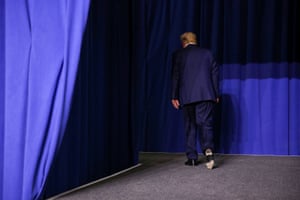
New York
By the time we roll out of Chicago – a whistle stop characterised by a serious foreign policy pivot from Morrison, and an unfortunate photo opportunity in front of a McDonald’s smart board that built a visual bridge to Engadine for people familiar with the infamous internet meme (let’s just leave it at that) – and on to New York, the drumbeat is cacophonous, literally and figuratively.It is leader’s week at the UN general assembly, and the area around the headquarters is locked down. The streets teem with protesters and delegates, and groups of Africans gather on Forty-fourth Street to drum and sing. The UNgeneral assembly circus drives New Yorkers bonkers, the streets are gridlocked and the eateries overflow, but the vibrancy of it is quite wonderful: the convivial murmur of languages on the east side of Midtown, the colour and style of the clothing, the downing of late-night whiskey amid animated conversation.
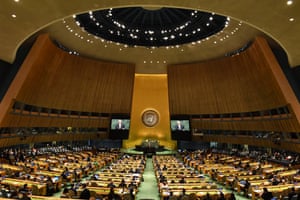
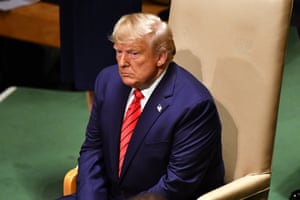
Morrison, comprehensively overshadowed by movements in the tectonic plates of the major powers, ploughs on diligently with his UN program and seems unperturbed by the misfortune of his two mates, Boris Johnson and Trump, hitting some serious turbulence. If the prime minister had any regrets about taking hospitality from Trump and aligning Australia’s diplomatic language precisely with the president on some thorny geopolitical issues, he certainly didn’t show it.
A certain defensiveness did creep in on climate change, though. Morrison wasn’t cranky but there were persistent pesky questions from the travelling media about Australia’s lack of policy ambition, and about his decision not to attend the UN climate summit on Monday. Even Trump called by. Why didn’t Morrison? There was the sound of prime ministerial teeth being gritted.
Interestingly, Morrison’s speech to the UN general assembly, which was billed initially as being an address about practical environmentalism, not climate change, drifted back into climate. There was a significant chunk defending his government’s policies, and some umbrage at the media for feeding false narratives – not fake news, mind you, but stoking prejudicial sentiment.
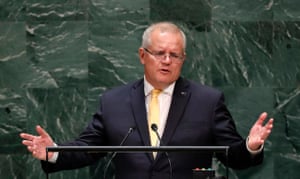
The Atlassian founder went to the climate summit to commit his company to a target of net zero emissions by no later than 2050. Cannon-Brookes nudged Morrison on Twitter: “Please give us a future we can believe in tomorrow. Inspire us. Lead us. Don’t bullshit us. I’m happy to help, as are millions of Aussies.”
I meet Cannon-Brookes at the Flower Shop, a hipster bar on the Lower East Side. His minders invited us down for a beverage. Most of my colleagues are punctual but I’m late, because the traffic is terrible, and the bearded tech entrepreneur lobs late as well. There is an overwhelming smell of weed that eddies through the bar as we settle in, which I stress is not connected to anyone in our group or Atlassian’s.
I don’t know who is responsible for this licentiousness and don’t intend to investigate, frankly – but it’s surreal, meeting a thirty-something billionaire in a bar as the bookend of this bonkers week, and having the bar reek of marijuana – that I find it hard to stop laughing at the unlikeliness of it all. It caps off the Through the Looking Glass sensation of the US odyssey.
The evening is convivial and, unsurprisingly, there is much impassioned talk about climate change and energy policy and a fair sprinkling of acronyms – a bunch of Aussies jousting good naturedly about the future of the planet in a bar in Manhattan. I leave Cannon-Brookes downstairs shooting pool with a few stayers, settling in to welcome the dawn, and head uptown, clearing my head by walking up Forty-fifth Street as the dumpster trucks and the street sweepers move into high gear for the pre-dawn cleanse.
I engage a cop at a checkpoint just to make sure I haven’t veered wildly off course in a desperate bid for oxygen. “The Roosevelt is just up here,” I inquire, “right?” The cop smiles and sips his coffee. “I’m from Brooklyn, m’am.”

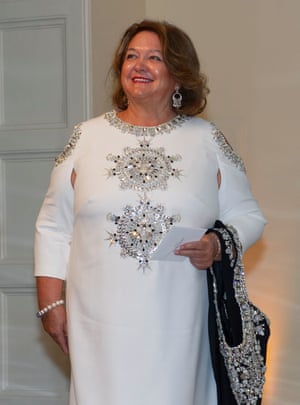
No comments:
Post a Comment